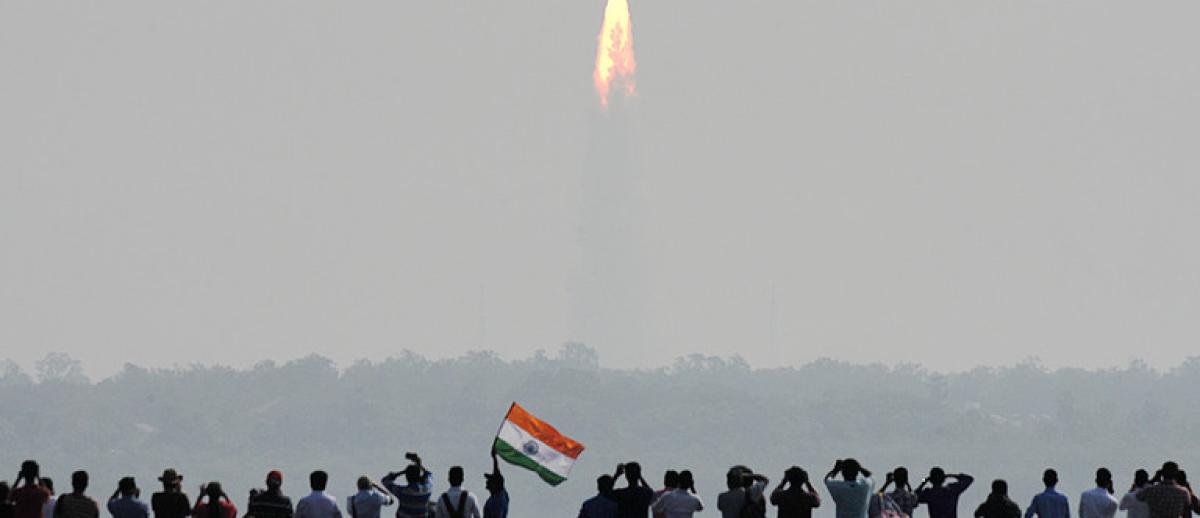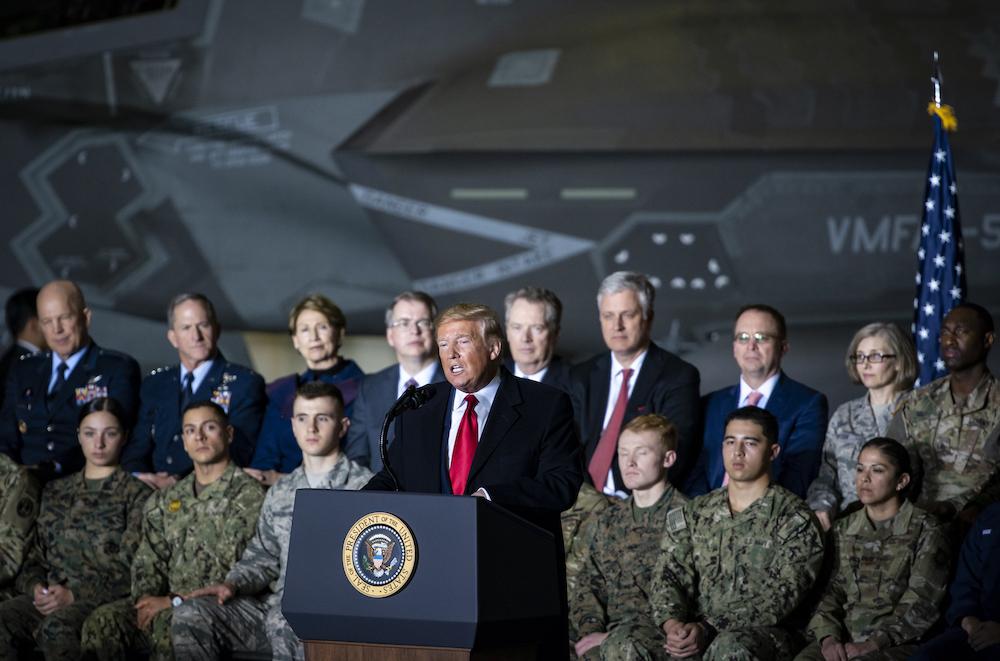The Military and Policy Implications of Space Race 2.0
archive


Spectators watch the launch of an Indian Space Research Organisation (ISRO) rocket from the Satish Dhawan Space Centre in Sriharikota, Andhra Pradesh. (Source: AFP)s
The Military and Policy Implications of Space Race 2.0
For some time now, space has been crucial to human activity. Our societies are almost entirely dependent on space systems for all kinds of technologies, from GPS to the ATM, from phone calls to gas pipelines. As Massimo Pellegrino and Gerald Stang observe in their report published by the European Union Institute for Security Studies (Space Security for Europe, 2016), every cutting-edge technology being adopted these days in highly-developed economies involve space-based (and mostly unprotected) systems. In military terms, such dependence is even more emphatic. Precision weaponry, drone surveillance, and real-time field communications are indispensable in the 21st century. Consequently, with the growing number of countries and players interested in space capabilities, outer space is being exposed to additional strategic competition and even conflict, with threats ranging from anti-satellite weapons to “hybrid” operations and cyberattacks. China and Russia have already engaged and invested in this domain in order to challenge US dominance, while countries like India and Brazil are striving to access what they refer to as a 'global common'—one whose rules, although subject to conflict, are evolving very rapidly (Pellegrino and Stang, 2016).1
NATO as a space security actor
At the December 2019 NATO Leaders' Meeting in London, confirming the crucial role of the Alliance for the North Atlantic area, space was officially recognized as a new operational domain alongside air, land, sea, and cyber domains. The Secretary General, Jens Stoltenberg, assured that NATO had no intention of putting weapons into space and that the Alliance's approach to space would remain fully in line with the international law.2
October 2020 saw defense ministers decide to establish a new NATO Space Centre at the Allied Air Command in Ramstein, Germany. It is designed to help coordinate and support Allied space activities, including communications and satellite imagery, and protect Allied space systems by sharing information about potential threats.3
Correspondingly, space is seen as essential to the Alliance's deterrence and defense. It underpins NATO's ability not only to navigate and track hostile forces but also, and most importantly, to detect missile launches and to ensure effective command and control. According to NATO data, more than 2,000 satellites currently orbit the Earth, around half of which are owned by NATO member countries.4
NATO arguably remains the most prominent and relevant (if not useful) element of the international security environment. As such, its military potential and operational experience would not carry much weight without adequate recognition of existing threats and challenges to its members and international system.
International legal context
Even if countries treat space as the next domain of war, just as they do with cyberspace, space presents fundamental challenges, different from the three traditional warfare domains (air, land, and sea). Space is a perfectly transparent, friction-free environment. For this reason alone, its usefulness is relatively limited. In fact, space has not been properly militarized, but that is not to say that it has not been used for military purposes. Hundreds if not thousands of military satellites are orbiting around Earth performing all manner of communication and reconnaissance functions, and providing the terminal guidance for all major weapons systems.
Two international legal norms currently govern the military-related uses of space. Firstly, national sovereignty claims do not apply beyond the Earth’s atmosphere and secondly, and more significantly, weapons cannot be deployed there. The foundation of international space law is the 1967 Outer Space Treaty, which explicitly states in Article IV that: “The Moon and other celestial bodies shall be used by all States and Parties to the Treaty exclusively for peaceful purposes. The establishment of military bases, installations and fortifications, the testing of any type of weapons and the conduct of military manoeuvres on celestial bodies shall be forbidden.” 5 Ratified by 110 countries (as of December 2020) including China, Russia, and the USA, this is the most multilateral international space law to date. Questions remain, however, regarding its actual stipulations, in particular the definition of ‘militarization’ of space.6

Leaders of Great Britain, the Soviet Union, and the USA sign the Outer Space Treaty on January 27, 1967. (Source: United Nations)
The Moon is also an object of international law. The "Moon Agreement" stipulates (in Article III) that the Moon and other celestial bodies in the solar system: a) can be used only for peaceful purposes by State parties, b) any threat of the use of force or the actual use thereof is strictly prohibited, and c) it should remain a nuclear-free zone.7 However, being currently ratified by only 18 states excluding China, Russia, or the USA, the implementation of the agreement is somewhat limited.8
The body of international law regarding outer space and celestial bodies is therefore rather deficient. In practice, it does not completely prevent states from performing military-related activities beyond the Earth’s atmosphere
Chinese assertiveness in space
As early as January 2007, China appeared to have shot down one of its weather satellites. This move brought several critical comments from the US and Australia.9 Against the backdrop of cross-strait sensitivities, numerous experts worried that China’s action was yet another 'muscle flexing' exercise. Liu Jianchao, the Foreign Ministry spokesman at the time, gave assurances that even though the test had been carried out, China was committed to the "peaceful development of outer space." Consequently, it reaffirmed its opposition the competitive militarization of space.10
[W]ith the growing number of countries and players interested in space capabilities, outer space is being exposed to additional strategic competition and even conflict.
Beijing has made impressive technological and scientific progress since its first official step into space back in 1964 when China launched and recovered an experimental biological rocket carrying white mice.11 In 1970, the first Chinese satellite was launched, making China the fifth country to send satellites into space. Less than thirty years later, Beijing managed to send its first unmanned spaceship. From then on, developments progressed very quickly: in 2019 a Chinese lunar probe managed to land on the far side of the Moon's (the first country in history to successfully do so); on December 1, 2020, another probe successfully landed on the Moon's surface and shortly thereafter brought samples back to the Earth. Chinese ambitions are, however, far-reaching and include, among others, landing on Mars in 2021,12 establishing a permanent space-based scientific station by 2022, and setting up a space-based solar power station by 2035.13
American response
To the already existing five military branches in the US military arsenal, President Trump added a sixth branch—the U.S. Space Force (USSF)—on December 20, 2019.14 Largely seen as a reaction to growing Chinese and Russian ambitions in space, the USSF has been charged with three primary functions: (a) to provide for freedom of US operations in, from, and to space; (b) to provide independent military options for joint and national leadership, and (c) to enable the lethality and effectiveness of the joint force. USSF is supposed to have both combat and combat support capabilities to allow prompt and sustained offensive and defensive space operations and joint operations in all domains.15

Former US President Donald Trump speaks at Joint Base Andrews in Maryland on December 19, 2019, after signing the bill that created the new U.S. Space Force. (Photo: Bloomberg)
Widely criticized by US experts,16 international media have been even more skeptical, seeing the establishment of the USSF as equivalent to a space race 2.0.17 Moreover, it points to a more ominous trend towards militarization. The 2019 Missile Defence Review explicitly states that: “the space-basing of interceptors may provide the opportunity to engage offensive missiles in their most vulnerable initial boost phase of flight, before they can deploy various countermeasures.”18
It is premature to offer any definite views on the effectiveness of such endeavors, given the complexities of space operations and the exorbitant costs of technology used. Nevertheless, the trend towards militarization raises substantial concerns about the future of global security and therefore demands that global institutions redouble their efforts to more tightly codify international law so as to maintain the future peaceful use of space.
1. See more at: https://aerospace.org/sites/default/files/policy_archives/Space%20Security%20for%20Europe%20Jul16.pdf accessed 23 November 2020.
2. See more at: https://www.nato.int/cps/en/natohq/news_171028.htm accessed 23 November 2020
3. See more at: https://www.nato.int/cps/en/natohq/topics_175419.htm? accessed 23 November 2020.
4. “Meet Laryssa Patten, an engineer working to keep NATO’s technological edge in space” See more at: https://www.nato.int/cps/en/natolive/news_178740.htm accessed 16 February 2021.
5. Treaty on Principles Governing the Activities of States in the Exploration and Use of Outer Space, including the Moon and Other Celestial Bodies, 1966. See more at: http://www.unoosa.org/oosa/en/ourwork/spacelaw/treaties/outerspacetreaty.html accessed 23 November 2020.
6. Pavle Kilibarda, “Space law revisited: The militarization of outer space”, ICRC, Humanitarian Law & Policy, available at: https://medium.com/law-and-policy/space-law-revisited-the-militarization-of-outer-space-d65df7359515 accessed 23 November 2020.
7. Agreement Governing the Activities of States on the Moon and other Celestial Bodies, 1979. See more at: http://www.unoosa.org/pdf/gares/ARES_34_68E.pdf accessed 23 November 2020.
8. See more at: http://www.unoosa.org/documents/pdf/spacelaw/treatystatus/TreatiesStatus-2020E.pdf accessed 23 November 2020.
9. Staff Writers, “China Under Pressure To Explain Satellite Missile Strike”, SPACEWAR, available at: https://www.spacewar.com/reports/China_Under_Pressure_To_Explain_Satellite_Missile_Strike_999.html accessed 23 November 2020.
10. See more at: http://news.bbc.co.uk/2/hi/asia-pacific/6289519.stm accessed 23 November 2020.
11. Reuters, “TIMELINE-Major milestones in Chinese space exploration” available at: https://www.reuters.com/article/space-exploration-china-moon/timeline-major-milestones-in-chinese-space-exploration-idUSL1N2I90NP accessed 2 December 2020.
12. See more at: https://news.cgtn.com/news/2020-11-12/Graphics-What-is-China-s-future-plan-for-the-space-sector--VlQBaCCZ3y/index.html accessed 2 December 2020.
13. Stephen Chen, “China Space Agency Looks To Capture Sun's Power” available at: http://billionyearplan.blogspot.com/2011/09/china-space-agency-looks-to-capture.html accessed 2 December 2020.
14. See more at: https://www.spaceforce.mil/About-Us/About-Space-Force/ accessed 2 December 2020. The five existing branches are Army, Navy, Air Force, Marines, and Coast Guard.
15. See more at: https://aerospace.csis.org/wp-content/uploads/2019/03/UNITED-STATES-SPACE-FORCE-LEGISLATIVE-PROPOSAL.pdf accessed 2 December 2020.
16. See more at: https://www.brookings.edu/blog/order-from-chaos/2018/08/10/experts-offer-their-views-on-creating-a-space-force/ accessed 2 December 2020.
17. For representative views see: Namrata Goswami, “China Has a Head Start in the New Space Race”, The Diplomat, available at: https://thediplomat.com/2019/05/china-has-a-head-start-in-the-new-space-race/ accessed 2 December 2020. Also Greg Autry, Steve Kwast, “America Is Losing the Second Space Race to China”, Foreig Policy, available at: https://foreignpolicy.com/2019/08/22/america-is-losing-the-second-space-race-to-china/ accessed 2 December 2020.
18. Missile Defence Review 2019. Available at: https://www.defense.gov/Portals/1/Interactive/2018/11-2019-Missile-Defense-Review/The%202019%20MDR_Executive%20Summary.pdf accessed 4 December 2020.



